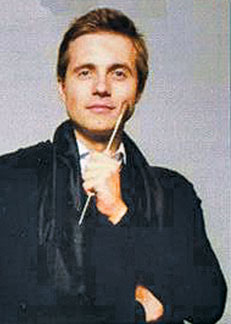Tchaikovsky’s winter daydreams in autumn
by Gwen Heart at the Royal Albert Hall
There is no doubt that one thing Britons do brilliantly is to perform
classical music. The rush to get to their seats tonight was one mad
scramble in which I too got pushed along until I reached my seat at the
Royal Albert Hall, the pristigious, most popular and revered theatre in
Britain. The Britons were dressed casually at this formal concert with
none of their scruffy overcoats.
 |
|
Presented by the BBC at the Royal
Albert Hall, London, the world-renowned conductor, Vasily
Petrenko takes on Tchaikovsky. |
Autumn was kind, gentle and soothing tonight. The vast arena
jam-packed rose together as the conductor of Oslo Philharmonic
Orchestra, Vasily Pettrenko with a loud round of applause as he entered
and stood centre-stage.
The occasion was BBC’s presentation of the 119th Season of the Henry
Wood Promenade Concert.
Tonight, Tchaikovsky’s Symphony No. 13 in G minor, Winter Daydreams
took off with no fuss or fervour. A treat to watch the massive orchestra
with those talented musicians so very professional, it appeared
Pattrenko had no problems with his baton.
Symphony
This Allergo Tranquillo symphony begins as no other symphony of his;
more quietly or undemonstratively, yet within the next couple of minutes
the unassuming flute and bassoon theme and especially the nervous
chromatic idea that swiftly accompanies it, have built an opening to
extend a self sufficient shortest of transitions to the second movement
could have been inappropriate.
Which means that none of Tchaikovsky’s symphonic openings was ever to
grow more convincingly nor were his second movements to testify more
eloquently to his melodic powers. In the neatly proportioned to testify
more eloquently to his melodic powers. In the neatly proportioned
reminder of this first movement, two passages are especially striking,
they open out impressively and fade away to the end furtively.
Salvaged from an orchestra piece called The Storm, the hushed string
passage that opened and closed the second movement was composed in 1864
as a vacation exercise.
Conductor Petrenko rises to the occasion bringing down his baton
between these flanks which is the decorative side of Tachaikovsky’s art
and elaborate many of the 10 short phrases that make up to the oboe
theme followed up by the viola and flute theme that follows the oboe’s
fourth phrase.
Perhaps, the pervading gentle melancholy of this lovely Adagio offers
some justification for the title given by Tchaikovsky which I find
difficult to understand. Yet, it is so alive and clear in character.
But why Winter Daydreams? This Symphony No. 1 in G Minor, Op. 13
composed in 1866 and revived in 1874, explains all that is played
tonight:
Daydreams of a Winter Journey; Allegro Tranquillo
Land of Desolation, Land of Mists; Adagio canatbile ma non tanto.
Shcherzo; Allegro scherzando giocoso
Finale; Andante lugubre – Allegro moderato – Allegro maestoso – Allegr
vivo.
These four major movements were combined in Winter Daydreams.
In particular, in the finale the Russian folk song is the foundation
both in the slow introduction and rough second movement, in the ensuing
sonate movement.
Winter Daydreams, however, is not Tcahikovsky’s outstanding scores
but he was one little surprise which is the return of the slow
introduction after the recapitulation of the first movement followed by
a horror passage leading to the second which probably fill out the
blueprint of a sonata form with a mixture of melody and counterpoint. I
find the finale lacks that inner growth that makes the opening movement
so impressive but provides an effective ending. For me it was listening
experience that ruffled my head. Some of the movements simply bored me.
When finally Petrenko brought down the baton on the last note, I was
relieved. That is as far as Tchaikovsky is concerned but he is beyond a
single symphony that may not appeal to me and to so many music lovers
like me. Apart from that feeling, to me Tchaikovsky’s symphonies are
like a tale of two halves.
The first half begins with Daydreams on a Wintry Road which is the
maestro’s own title for the first movement of his first symphony which
feels like a fairy-tale, albeit minus the beofsa Polish dance and the
Finale to his Third Symphony.
The second half was scored two years later and together what I am
listening to right at the moment along with about one thousand people.
Tchaikovsky himself confirmed what is already unmistakable; that this
is a drama of fate and of mankind’s struggle to evade it. His symphonic
career ended barely two months before his death with the tragic slow
finale to his sixth symphony ebbing into abject gloom.
Audience
Something tonight’s audience felt after the last note died and faded
off.
Vasily Petrenko, tonight’s conductor, is the chief conductor of the
Oslo Philharmonic Orchestra and many other famous orchestras. Born and
educated in St.Petersburg, he is also the chief conductor of State
Academy Orchestra of St.Petersburg. Enjoys a firm relationship with the
world’s leading orchestras.
In the USA, he made a successful debuts with the Philadelphia
Orchestra, Los Angeles Philharmonic and the Boston, Chiago, San
Francisco, and St.Louise Symphonic Orchestra.
His wide operatic repertoire includes Macbeth (Glyndbourne Festival
Opera) Eugene Onegin (Opera de Paris). Boris Gudunov (Netherlands
Reisopera) and The Queen of Spades (Hamburg State Opra).
Oslo Philharmonic Orchestra this fabulous and world renowned
orchestra consists of 16 – First Violins, 14- Second Violins, 14-
Violas, 2- Contra Bassoons, 1- Tuba, 1- Celesta, 10- Celles, 8- Double
Basses, 4- Flutes, 6 – Horns, 1- Timpani, 1 – Piccolo, 5- Oboes, 5 –
Clarinets, 4 – Trumpets, 2- Harps, 2 – Bass Clarinets, 1 – Alto
Saxophone, 4 – Bassoons, 4 – Trombone and 1 – Piano. |

